This almond crusted salmon has a thick and crunchy coating on the outside with buttery, rich salmon on the inside. Slightly sweet, a little tangy, and a touch of spice, it’s a savory entree that’s full of unique, delicious flavors.
If you love salmon, be sure to try herb crusted salmon, salmon with mango salsa, or tahini ginger salmon next.
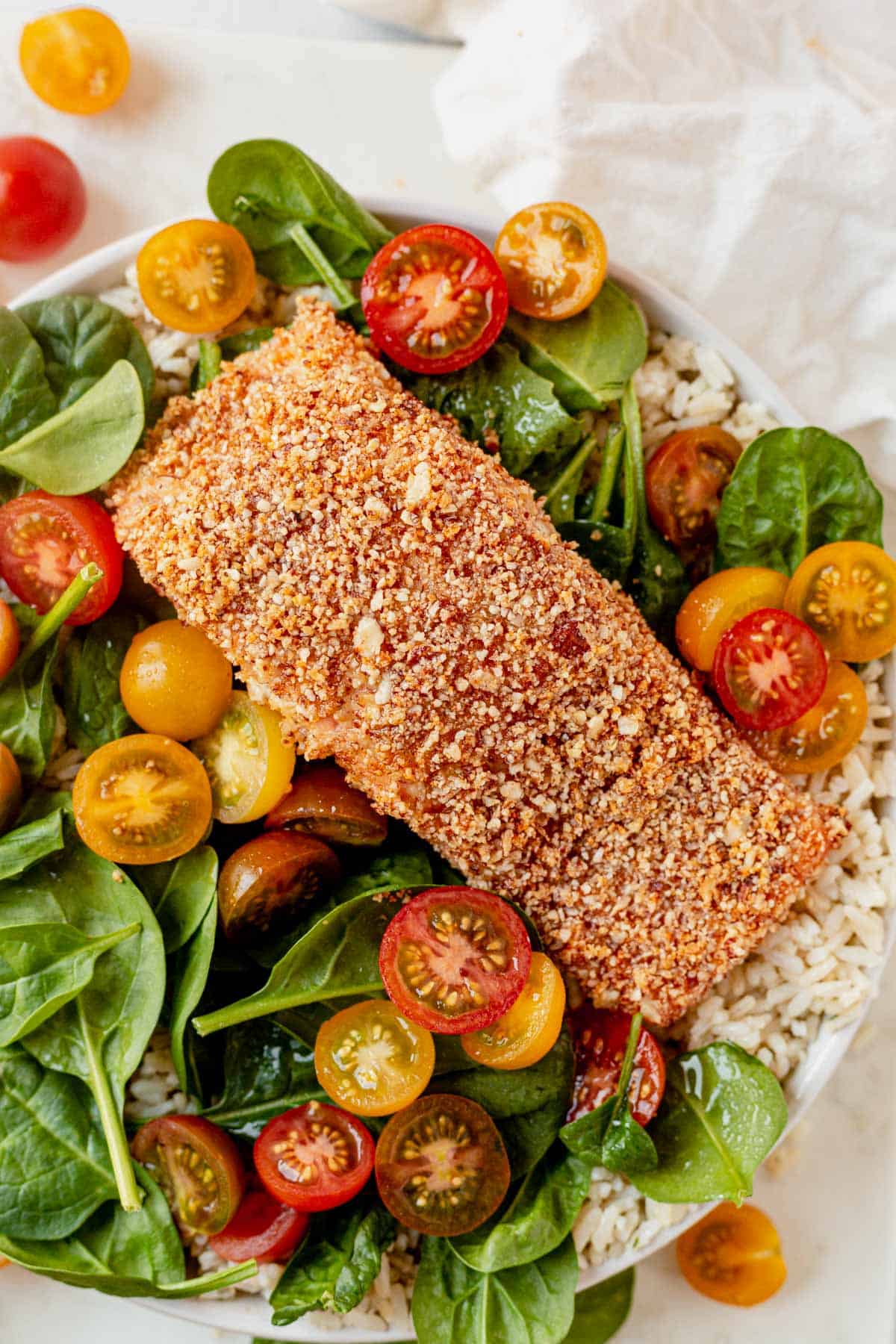
One of our favorite ways to tackle the challenge of an easy, nutritious dinner on busy weeknights is with salmon.
If you’re a fan of delicious salmon recipes, give this Teriyaki Glazed Salmon or Everything Bagel Salmon a try.
Table of Contents
- Why this Almond Crusted Salmon Recipe Works
- Grab These Ingredients
- Recipe Variations
- How to Make Almond Crusted Salmon
- How to Make It in the Air Fryer
- Recipe FAQs
- What Brings Out the Flavor of Salmon?
- Expert Recipe Tips
- How to Serve Almond Crusted Salmon
- Storing Leftovers and Reheating
- More Easy Salmon Recipes
- Almond Crusted Salmon Recipe
Why this Almond Crusted Salmon Recipe Works
- It’s an easy, healthy salmon recipe that’s done in 20 minutes or less. Throw it together as one of your easy dinners on rotation or have it for lunches throughout the week.
- Every bite of fresh salmon is full of bold flavor. This is sure to become a go-to weeknight salmon dish or healthy lunch you can prep in bulk over the weekend.
- You can feel good about serving your whole family this healthy dinner, full of protein and fatty acids.
- It tastes great with a variety of sides and veggies, so you never have to have it the same way twice!
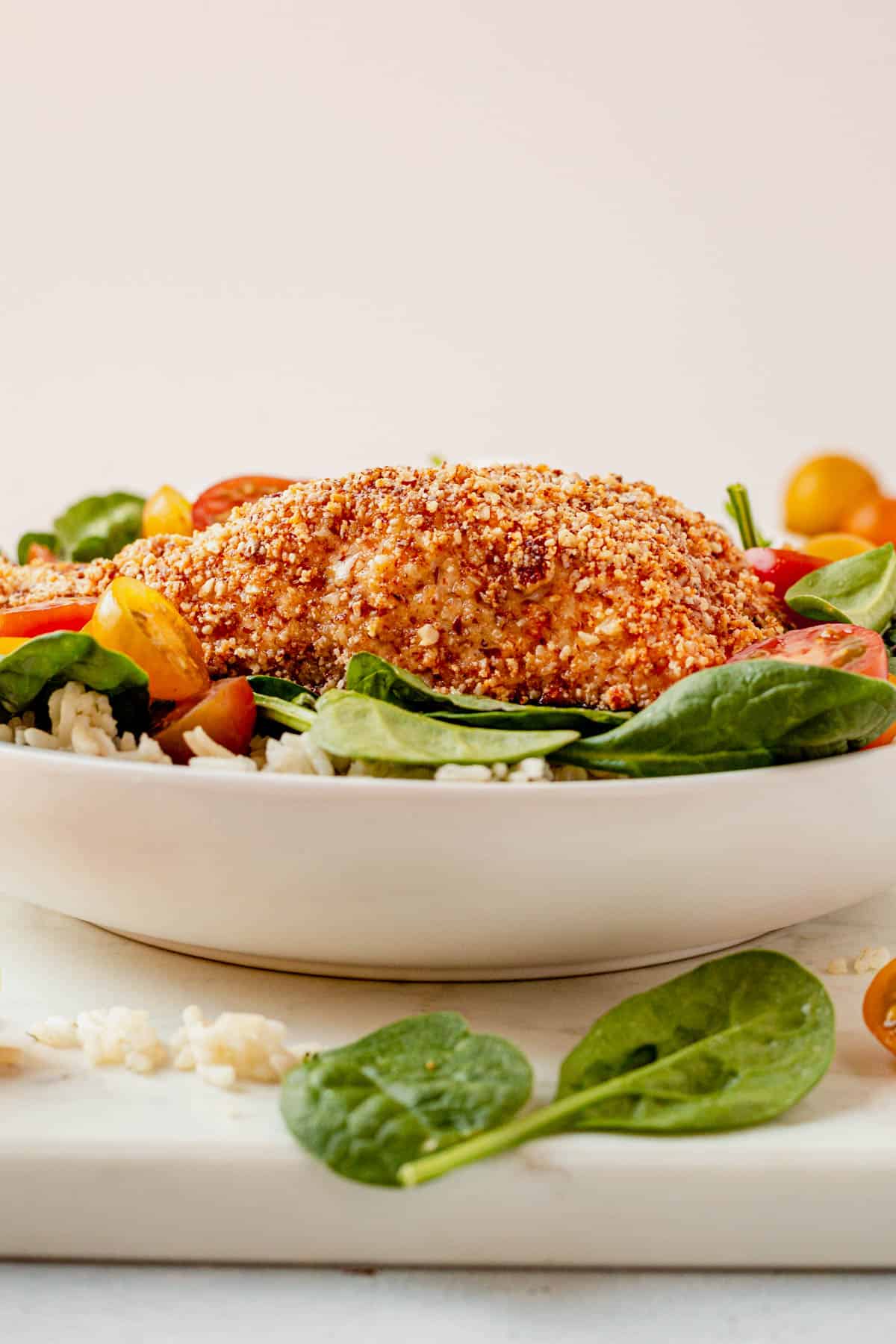
Grab These Ingredients
Here are the simple ingredients for this Almond Crusted Salmon recipe. Most are pantry staples and easy (and affordable) to find in grocery stores. Jump down to the recipe card for exact measurements.
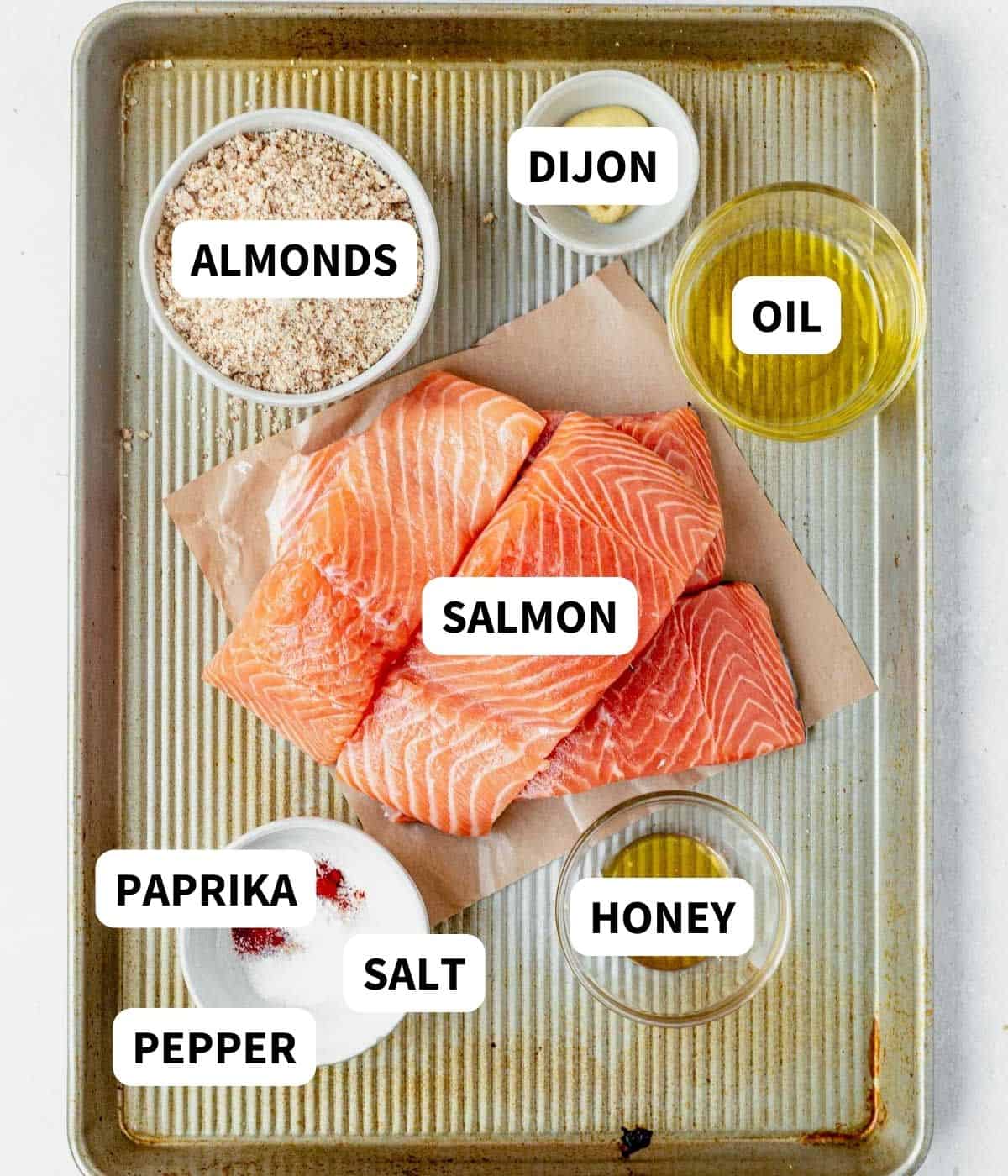
- Salmon: This recipe works best with center-cut filets.
- Almonds: You’ll want to try and use raw unsalted almonds and finely chop them to make that crunchy almond crust. (If you’re working with whole almonds and don’t have a food processor, you can add them to a plastic bag and use a rolling pin to crush them up.) You can also use almond meal or almond flour, which still has the color and texture that you want from the almond skin.
- Olive oil: Half of the olive oil will be used to bind the dry rub and half will be used to coat the salmon before topping it. You can also use avocado oil.
- Seasonings: Paprika, kosher salt, and pepper add a little flavor and spice to the almond crust.
- Dijon mustard: Adds a slight tanginess.
- Honey: Brings the perfect balance of sweetness to the heat and tang of the other flavors.
Recipe Variations
- Almonds: Almond meal could be used as a substitute for the ground almonds, as well as other nuts like cashews or pistachios. Just know that ground nuts will have more texture than almond meal.
- Salmon: If you’re not a fan of salmon, you could try another mild-tasting fish like tilapia or cod.
- Seasonings: You can add as much kick to the almond crust as you’d like by adding more or less paprika (or other spices you enjoy). Feel free to get creative and add fresh herbs, parmesan cheese, sesame seeds, or lemon zest to your almond mixture.
- Dijon: Yellow has a milder flavor than dijon. Spicy brown mustard has a similar tang and heat but has a slightly more robust flavor. If you’re using honey mustard, just omit the regular honey from the recipe.
How to Make Almond Crusted Salmon
The full printable recipe is below, but let’s walk through the steps with some photos and a video so you have a clear idea of what to expect. This almond crusted salmon recipe is really easy and these step-by-step instructions will make sure they turn out every time.
Almond coating: Mix 1 tablespoon of olive oil with the almond, paprika, salt, and pepper in a shallow medium mixing bowl or dish, large enough to fit a salmon filet.
In a separate small bowl, mix the dijon mustard, honey, and remaining olive oil.
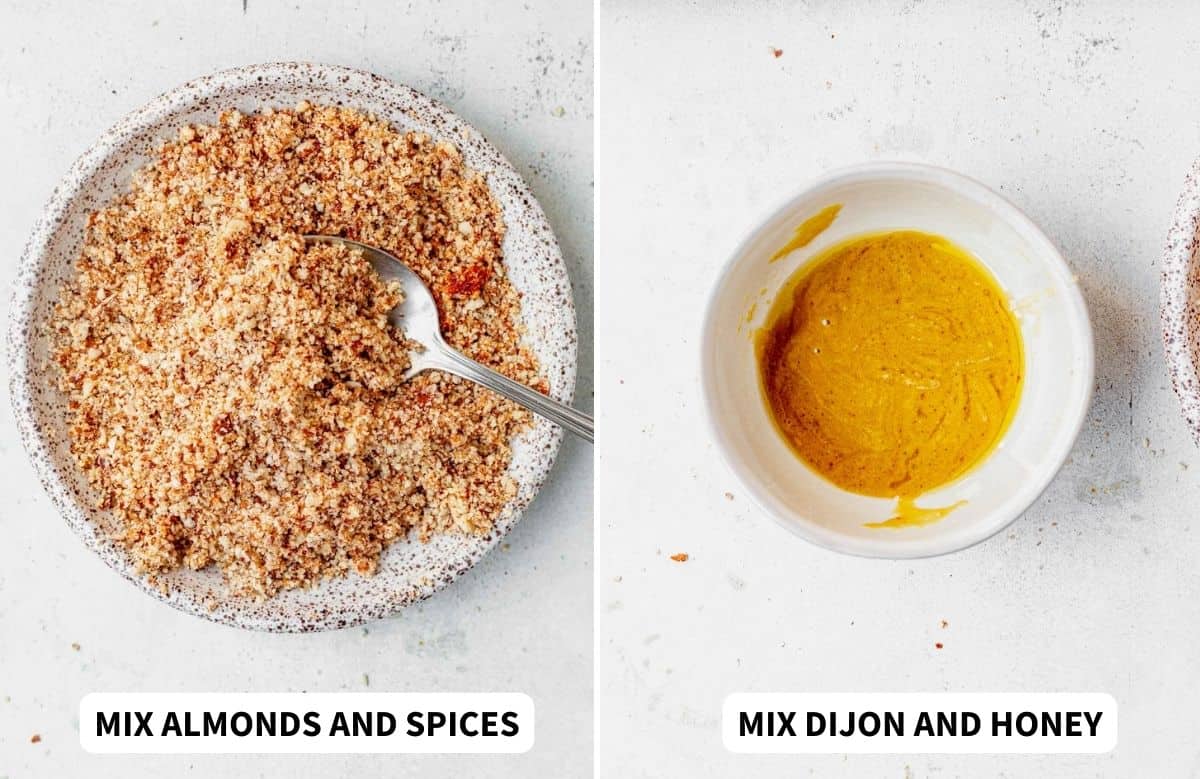
Prep the salmon: Pat the salmon dry with a paper towel. Brush the honey dijon mixture on the tops and sides of the salmon fillets.
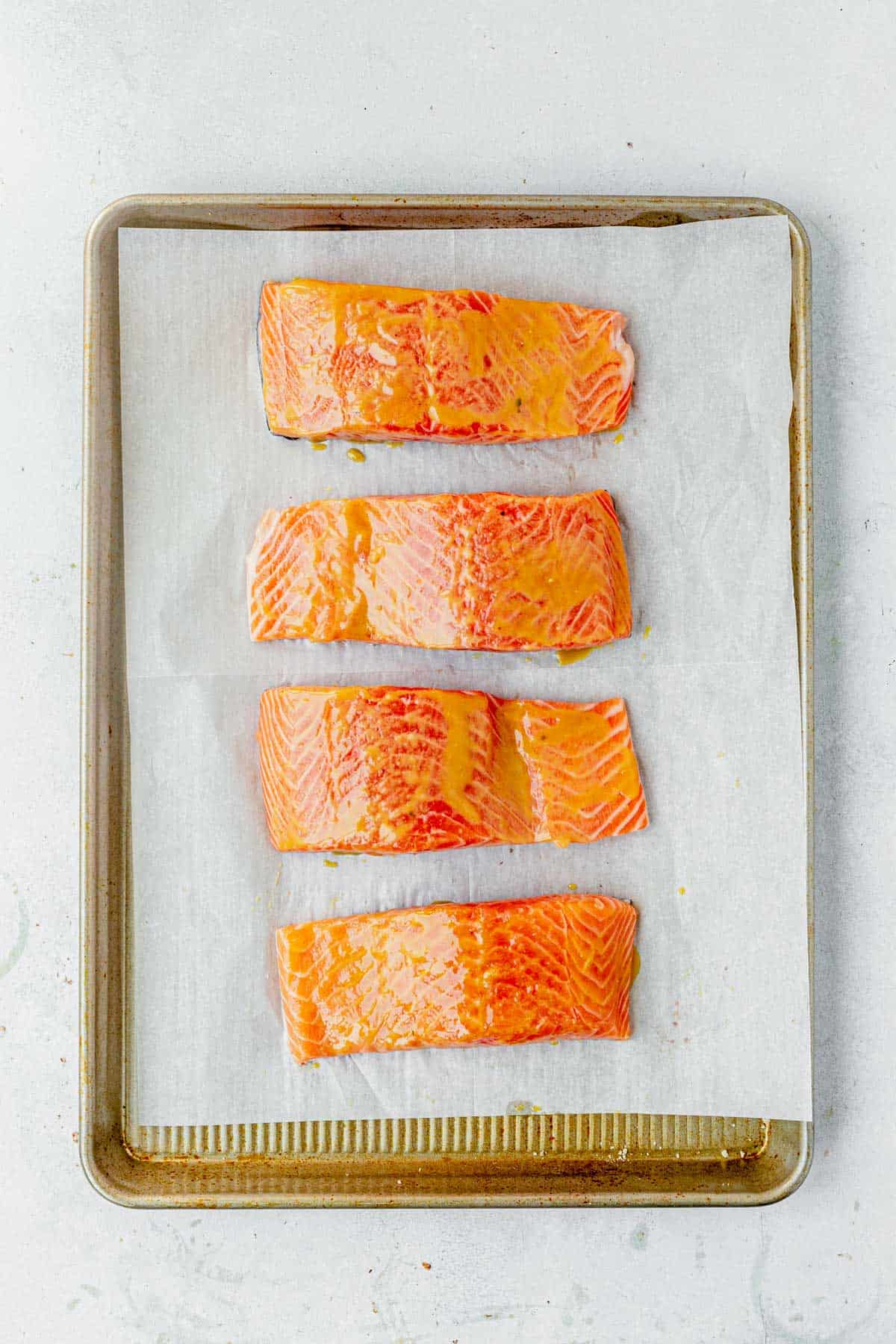
Coat: Dip each salmon filet in the almond mixture one at a time, pressing the top of each filet firmly into the mixture.
Be sure to roll the sides of the fish in the almond mixture as well, coating all sides of fish. Feel free to sprinkle any of the remaining crumb mixture over top of the coated salmon and pat it down.
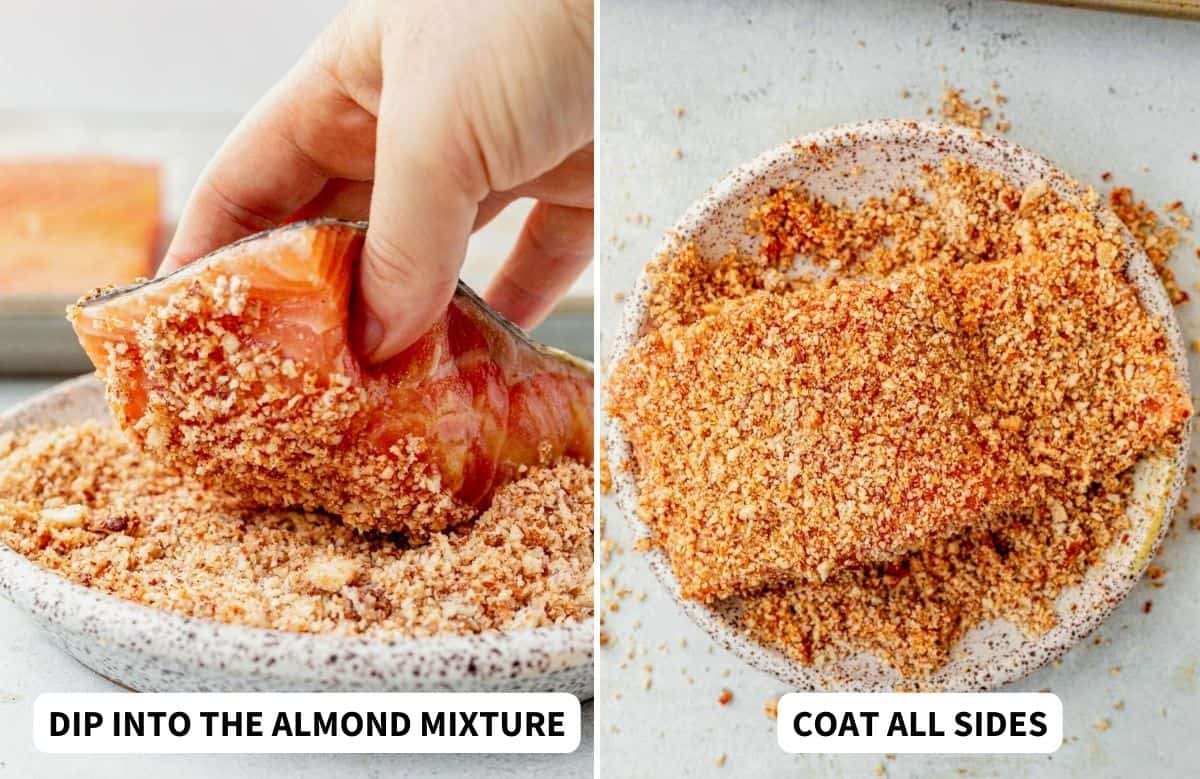
Bake: Place skin side down on parchment paper in a baking sheet or in a baking dish and bake in the preheated oven at 400°F for 13-16 minutes. Cooking time will vary depending on the size of the salmon.
Pro tip: Remove the salmon from the oven when it reaches 135°F, allowing for 5-10 degrees of carryover cooking. You can learn more about how long to bake salmon at 400.
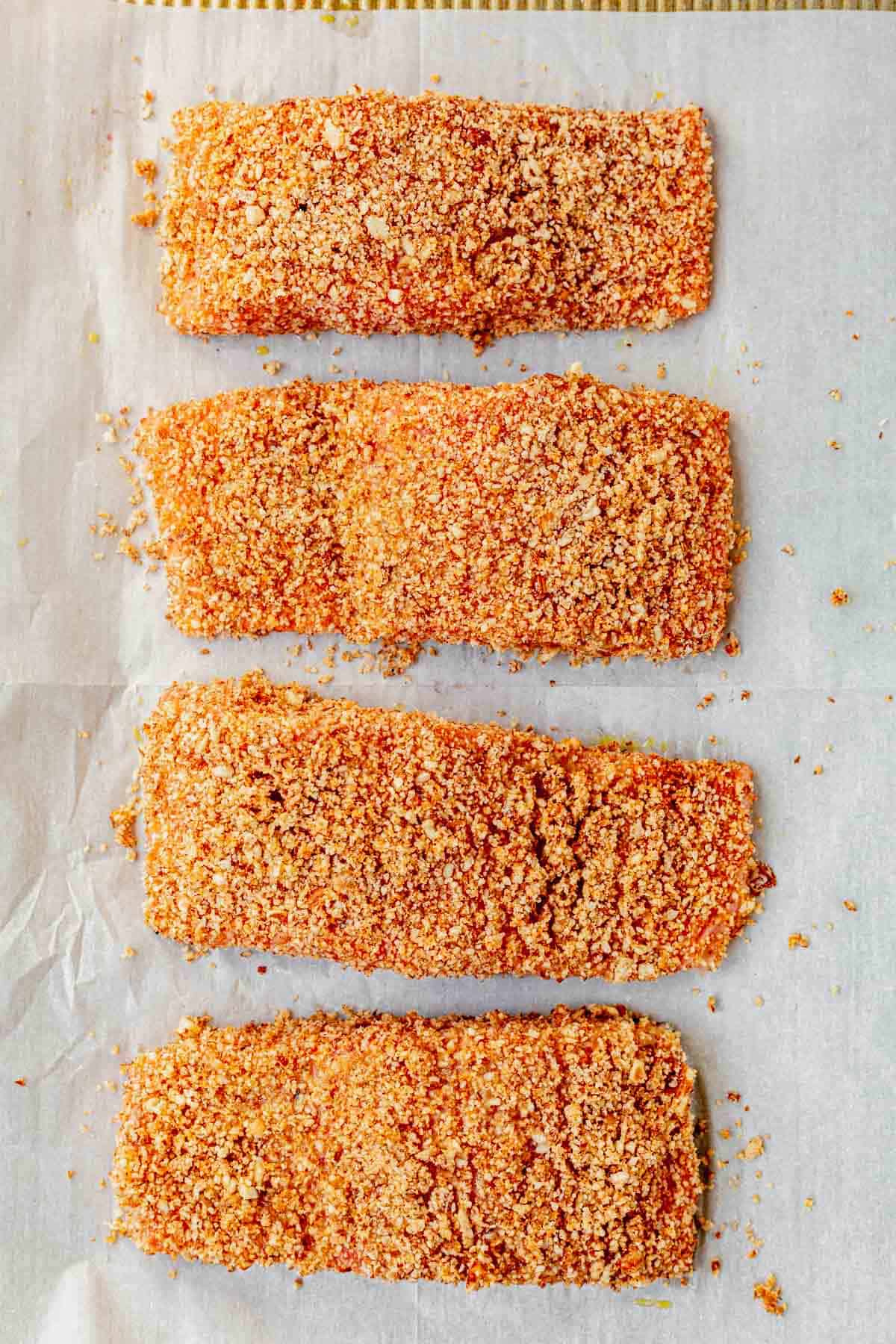
How to Make It in the Air Fryer
Follow the instructions to coat the salmon in the sauce and almond mixture. Lay the salmon in an even layer in the bottom of the air fryer basket, without them touching.
Air fry at 400°F for 10-13 minutes, or until the internal temperature reaches about 140°F to allow for 5 degrees of carryover cooking.
Recipe FAQs
It really comes down to a preference when choosing to bake or fry salmon. Baking requires less oil or fat, achieves a more evenly cooked salmon throughout, and better retains moisture to ensure a tender and flaky texture. Frying salmon gives it a crispy exterior, especially when coating it. It also is generally faster than baking and creates a nice golden crust that adds a satisfying crunch.
You can make pan-seared salmon, but some of the coating may come off in the pan and the cleanup isn’t as easy. Frying it in oil adds oil and flavor. Heat a bit of oil in a saute pan over medium-high heat. Once it’s hot, place the salmon skin-side-down into the oil and cook for 3-4 minutes. Carefully flip the salmon over and cook for another 3-4 minutes. Turn to each side and cook for 1-2 minutes on each, or until the internal temperature reads about 135°F.
What Brings Out the Flavor of Salmon?
- The citrus from lemons can add a nice tang to salmon. Squeeze fresh lemon juice over the cooked salmon or top it with thin lemon slices.
- Adding fresh herbs like dill, parsley, tarragon, or chives is a great way to elevate the flavor of salmon. Sprinkle chopped herbs over the cooked salmon or incorporate them into a sauce or marinade.
- Sprinkle or rub seasonings or spices of your choice on the salmon before cooking to add depth and complexity and enhance the flavor.
- Just a drizzle of high-quality olive oil goes a long way in enriching the flavor of salmon and making it rich and moist.
Expert Recipe Tips
- Wild-caught Alaskan salmon is always my first choice of salmon. It usually means it’s farm-raised if it says “Atlantic salmon.” If you have the option between wild-caught salmon and Atlantic go with wild-caught!
- We like to order ours from Sitka Salmon Shares, which is a great supplier of salmon and ships directly to your door.
- Get salmon filets that is all the same size. Getting uniform salmon filets means they will all cook at the same pace, so you aren’t left with one perfectly cooked filet and one overcooked.
- Cook time will vary depending on how thick the salmon is so use an instant read thermometer over cooking times.
- You’ll know salmon is done just before the internal temperature reaches 145°F (135-140° is ideal).
- Just like determining beef doneness, make sure to insert the thermometer into the thickest part of the salmon for the best reading when measuring the degree of doneness.
- The salmon should be firm to the touch and the fish flakes should come apart easily as you cut.
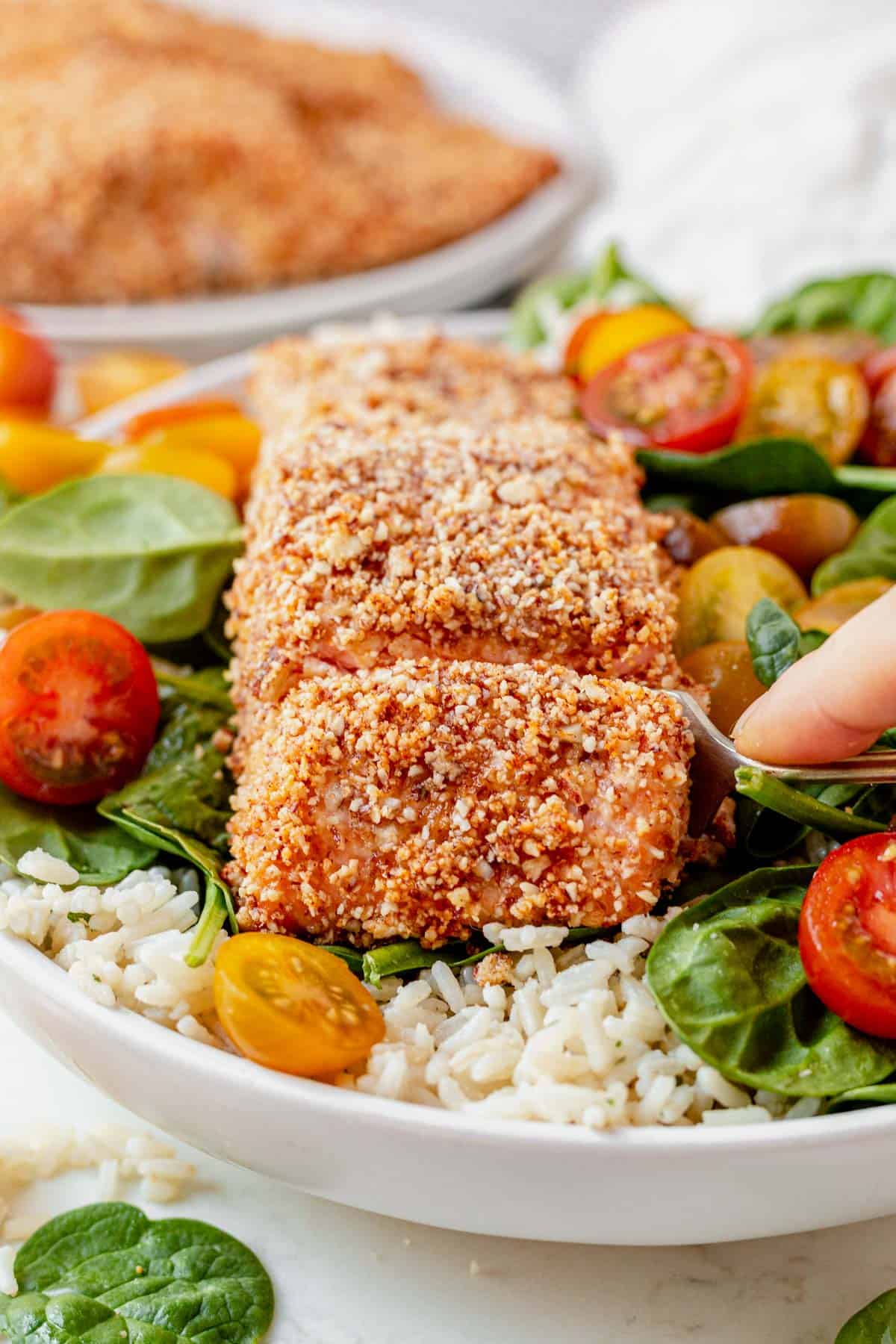
How to Serve Almond Crusted Salmon
This easy recipe makes the perfect base for your next dinner or lunch. Here are some ideas of what to serve it with:
- Have it with a side of veggies like green beans, brussels sprouts, or this air fryer asparagus that’s done in under 10 minutes. Like the salmon, it’s crispy on the outside and tender on the inside.
- Serve it up alongside our easy sweet potato salad.
- These maple-glazed carrots are the perfect sweet and savory veggie complement.
- Have it as extra protein on top of this strawberry spinach salad. Or lay it on a bed of lettuce to make your own delicious salad with your favorite greens and toppings. Dress it with our creamy jalapeno ranch, a balsamic vinaigrette, or simply lemon juice.
- Add some carbs and lay it over a bed of fluffy coconut rice (on the stovetop or in the instant pot). Or try it with potatoes like these hasselback sweet potatoes, dairy-free mashed potatoes, or air fryer baked potatoes.
Storing Leftovers and Reheating
To store: store leftover salmon in an airtight container in the fridge for up to 2 days. Have it cold on top of your favorite simple salads or have it warm with veggies and rice.
Reheat it in the oven at 350 until it is warmed through, or pop it in the air fryer for a few minutes or microwave for 30-second increments until warmed through.
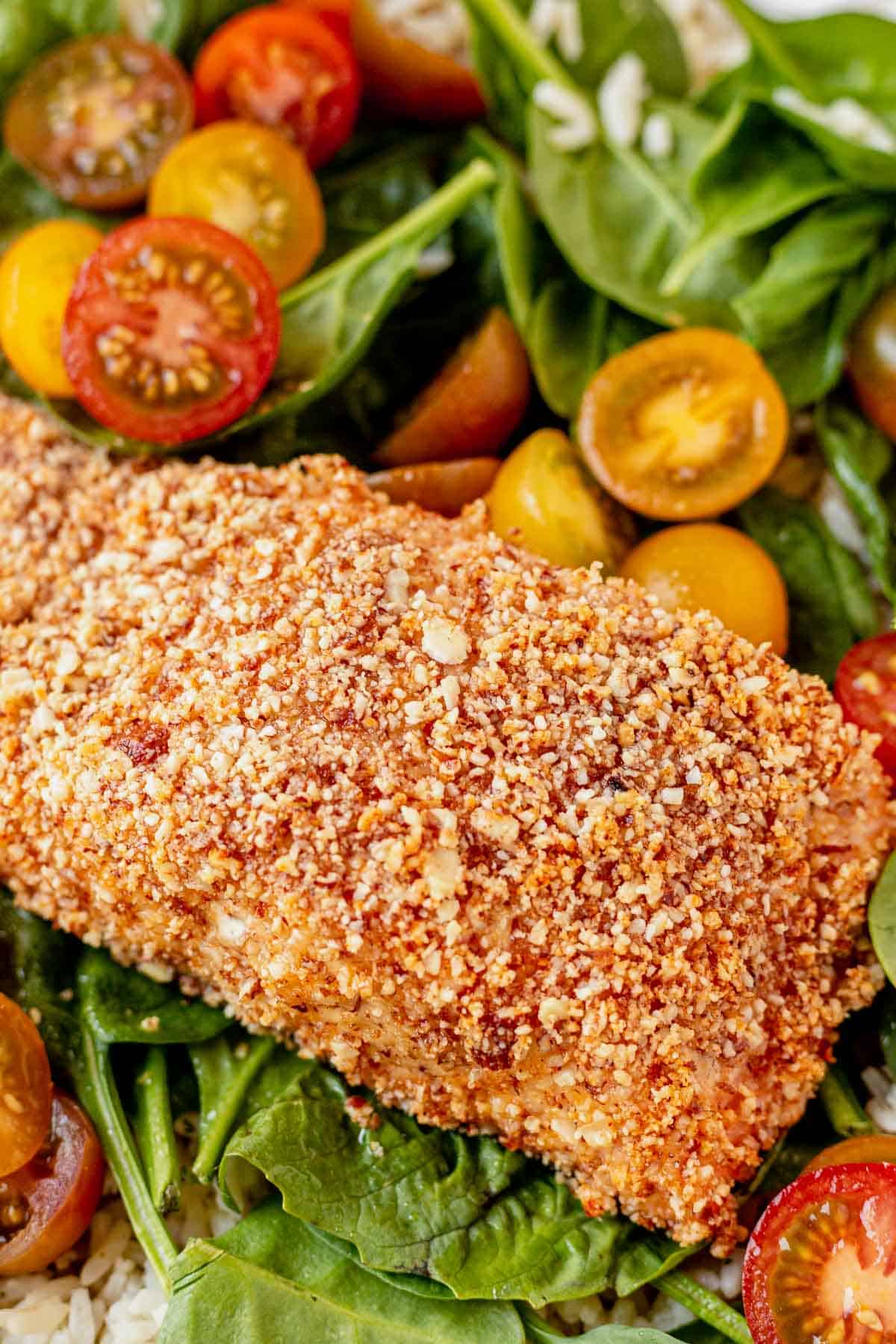
If you make this recipe, I’d love for you to give it a star rating ★ below. You can also tag me on Instagram so I can see it!
More Easy Salmon Recipes
- Tahini Ginger Salmon with Sesame Asparagus (Sheet Pan)
- Air Fryer Salmon Bites
- Salmon Pesto Pasta
- Honey Garlic Salmon Rice Bowl
Almond Crusted Salmon
Save this Recipe!
Ingredients
- 4 (5-6 ounce) center cut salmon filets (Note 1)
- 3/4 cup finely chopped raw unsalted almonds (Note 2)
- 2 tablespoon olive oil divided
- 1/2 teaspoon paprika
- 1/2 teaspoon kosher salt
- 1/4 teaspoon black pepper
- 1 tablespoon dijon
- 2 teaspoons honey
Instructions
- Preheat the oven to 400°F. Line a large baking sheet or square baking dish with parchment paper and set aside.
- Mix together 1 tablespoon of olive oil with the finely chopped almonds, paprika, salt, and pepper in a large shallow dish, large enough to fit a salmon filet.
- Mix the Dijon mustard, honey, and 1 tablespoon of olive oil in a small dish. Pat the salmon dry with a paper towel and brush the honey mustard mixture on the tops and sides of the salmon filets.
- Dip the top flesh-side of the salmon into the almond mixture and press it down firmly to coat the entire top of the salmon. Roll the salmon to each side to coat the sides of the salmon. Transfer to the prepared baking sheet and repeat with the remaining salmon filets.
- Bake in the preheated oven for 13-16 minutes, or until the internal temperature reaches just below 135-140°F, allowing for 5-10 degrees of carryover cooking (so it reaches 145°F before serving). The cook time will vary depending on how thick the salmon is. The salmon should be firm to the touch and flake easily as you cut. See notes for air fryer instructions.
- Serve warm with your favorite sides or on top of greens as a salad or over rice with veggies.
Notes
Video
Equipment
- Parchment paper or foil
- Baking pan or baking dish
Nutrition
Nutrition information is automatically calculated, so should only be used as an approximation.
This post may contain affiliate links. Read our disclosure policy.

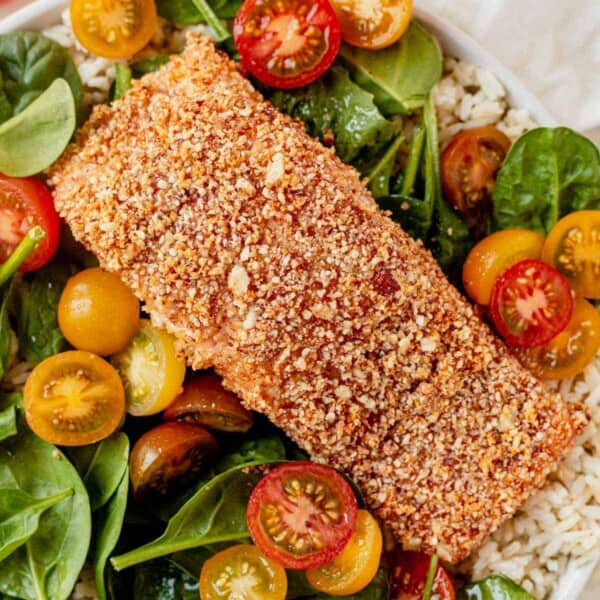









Great recipe. I did mine in the air fryer and it came up crunchy and perfect. Thank you
Was super easy to make and very tasty, however I would recommend letting the salmon marinade in the oil/honey/dijon mix for at least 15 mins so it soaks up the flavor.
Thanks, Allison!!